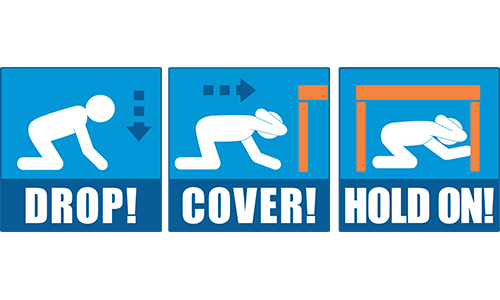UPDATE OCTOBER 19, 2022: This year’s International Great Shakeout is Thursday, Oct. 20 at 10:20 a.m. (local time). Millions of people worldwide will participate in earthquake drills at work, school, or home! Participate so you’ll know what to do during an earthquake.
ORIGINAL 2018 ARTICLE:
You may say to yourself, “We don’t have earthquakes in my area, so why should we participate?” The truth of the matter is that everyone, everywhere should know how to protect themselves during earthquakes – at home, at work, at school, or while traveling where earthquakes occur. If your school, hospital or university is in an area where earthquakes are rare, consider how often your students and staff may visit earthquake regions for conferences, sports, research or vacation. Also, others may one day move to earthquake-prone areas.
By participating in the Great ShakeOut, you can make sure they will be ready to respond appropriately.
Great ShakeOut Earthquake Drills are an opportunity for your campus community to learn and practice what to do during earthquakes (“Drop, Cover, and Hold On”), and to learn about your overall preparedness plans.
Millions of people worldwide participate each year by registering at www.ShakeOut.org/register, including many from K-12 schools, colleges or universities, hospitals and other large organizations. Participation can take less than 10 minutes.
Great ShakeOut Drills Started 10 Years Ago
ShakeOut began in southern California in 2008, based on the U.S. Geological Survey’s “ShakeOut Scenario” for a magnitude 7.8 earthquake along the San Andreas Fault. The regional one-time-only drill was organized by the Earthquake Country Alliance (ECA), a public-private-grassroots partnership of many organizations that provide earthquake and tsunami information and services.
The purpose of ShakeOut from its inception was to communicate scientific and preparedness information in order to motivate people to practice earthquake safety and to increase resiliency through preparedness and mitigation.
To facilitate participation, an online registration system and resource site (ShakeOut.org) was created that was used to register 5.4 million southern Californians in 2008. Participation increased to 10.5 million statewide by 2017, led by K-12 schools and higher education but also involving businesses, non-profits, hospitals, government agencies, neighborhoods groups, and households.
Everyone can ShakeOut! Since 2010, ShakeOut has expanded to include all U.S. states and territories, several Canadian provinces, Japan and New Zealand, along with independent participation of schools and other organizations from another 70 countries. More than 58 million people participated in 2017 worldwide. ShakeOut websites are now online in English, Spanish, French, Italian and Japanese.
Great ShakeOut Earthquake Drills are organized according to the Collective Impact framework, which has five key elements:
- Common Agenda: ShakeOut was created and continues to be implemented through strong partnerships among partners from the social and physical sciences, government emergency management at all levels, private sector organizations, school safety leaders, and non-profit community groups, encouraging participants to create their own ShakeOut. Unified messaging resources are provided to ensure that standardized messages are distributed by all partners.
- Shared Indicators and Measurement: ShakeOut’s registration system serves several goals. First, it allows individuals and organizations to pledge that they will hold a drill and indicate how many people will participate, along with describing their plans and other metadata. This information is then tallied locally, regionally, nationally and globally by geographic region and by participation category. These statistics have prompted others to participate and in some areas have led to friendly competition between counties or states. In addition, participants are listed (with their permission) on the website, by region and by category, which facilitates social cues that lead to expanded participation when a school, hospital or other organization sees that similar organizations are involved.
- Mutually Reinforcing Activities: ShakeOut has become a global infrastructure for providing earthquake information to the public and involving them in community resiliency, teaching people a life-saving response behavior while fostering a sense of community that facilitates further dialogue. A multi-sector approach is essential, with customized information provided for more than 20 audience categories (see ShakeOut.org/howtoparticipate). These include comprehensive drill manuals, an audio file to play during the drill, downloadable posters, flyers and artwork. Schools and districts use and distribute these materials and apply lessons learned from their drills to develop or revise their emergency plans. Many organizations and ShakeOut coordinators (at the local, state and national levels) develop their own ShakeOut resources, which they share with participants in other regions.
- Continuous Communication: Registrants receive monthly email updates providing drill instructions, preparedness and mitigation information, and access to a variety of resources available on their region’s ShakeOut website. ShakeOut’s social media (facebook.com/greatshakeout, www.twitter.com/shakeout and www.instagram.com/greatshakeout) encourages communication with others to seek additional information and confirmation of appropriate behaviors. It also recruits new participants within online discussions of actual earthquakes. Millions more learn about ShakeOut via broad news media coverage that encourages dialogue about earthquake preparedness.
- Backbone Support: Great ShakeOut Earthquake Drills are coordinated globally by the Southern California Earthquake Center, an earth science research center headquartered at the University of Southern California (USC). Primary funding for ShakeOut is provided by the Federal Emergency Management Agency, California Office of Emergency Services, National Science Foundation, U.S. Geological Survey, and other countries. SCEC created the (now) global ShakeOut website (ShakeOut.org), and its registration system with customized information for 27 distinct regions. SCEC also directly manages the California ShakeOut in its role as the administrative home of California’s Earthquake Country Alliance. SCEC was recognized in 2012 as a “White House Champion of Change” for driving these efforts. SCEC also created and manages TsunamiZone.org, a global registration system to assess participation in tsunami safety activities.
How to Register, Promote and Hold Your Own ShakeOut Drill
Today
- K-12 districts (and individual schools): register your entire staff and student population in your full-school drill, and use drill manuals and educational resources available at ShakeOut.org/schools.
- Colleges and Universities: Because students and staff are not always on campus each day, a special protocol has been established for registering your entire campus population:
- Use email, social media or your campus alert system to notify faculty, staff and students about the ShakeOut Drill and that your campus will be participating, using the messaging documents below and also at www.ShakeOut.org/messaging.
- Invite everyone to “Drop, Cover, and Hold On” during class or wherever they are at 10:18 a.m. on 10/18 (or whatever day/time your school is holding its ShakeOut drill). Instructor guides and a brief PowerPoint presentation for leading in-class 10 minutes drills (including discussion) are linked below.
- Encourage everyone to improve their preparedness for all emergencies. A guide for student earthquake preparedness is linked below.
- Include your organization’s emergency information in your email.
- Faculty and Instructors: If your campus will not be registering as a whole, you can register your department or class to participate in your region’s ShakeOut drill and use the resources provided below. Even if your school is registered, you can also register in order to receive information directly from ShakeOut organizers and be listed separately as a registrant (though not double counted).
Drop, Cover and Hold On
DROP where you are, onto your hands and knees. This position protects you from being knocked down and also allows you to stay low and crawls to shelter if nearby.
COVER your head and neck with one arm and hand.
- If a sturdy table or desk is nearby, crawl underneath it for shelter
- If no shelter is nearby, crawl next to an interior way (away from windows)
- Stay on your knees; bend over to protect vital organs
HOLD ON until shaking stops
- Under shelter: hold on to it with one hand; be ready to move with your shelter if it shifts
- No shelter: hold on to your head and neck with both arms and hands
Source: Earthquake Country Alliance
- Faculty and Instructors: If your campus will not be registering as a whole, you can register your department or class to participate in your region’s ShakeOut drill and use the resources provided below. Even if your school is registered, you can also register in order to receive information directly from ShakeOut organizers and be listed separately as a registrant (though not double counted).
Between now and Oct. 18 (or your ShakeOut day):
- Administrators: Meet with your campus safety committee to plan your drill, which can be limited to the short “Drop, Cover, and Hold ON” drill in classrooms, offices and dorms, or a more comprehensive exercise of your emergency plans. Include everyone on campus in your drill plans. Put the drill on your organization’s master calendar and website so everyone will know about it (web banner resources are linked below).Next, download resources for promoting and implementing your drill:
- ShakeOut College Messaging Suggestions
- ShakeOut College Instructor Guide
- ShakeOut College Instructor Presentation
- Example: USC Laboratory Earthquake Preparedness Guide
- ShakeOut Flyer for Colleges and Universities (October 18, 2018)
- ShakeOut Flyer for Colleges and Universities (generic)
- Additional promotional ShakeOut resources (posters, web banners, and much more)
- Seven Steps to Earthquake Safety for College Students
- Faculty and Instructors: Download resources for promoting and implementing your drill:
On Oct. 18, 10:18 a.m. (or whenever you schedule your drill):
- Drop, Cover, and Hold On: Have your faculty, staff, and students Drop to the ground, take Cover under a table or desk, and Hold On to it as if a major earthquake were happening (stay down for at least 60 seconds). Practice now so your staff and students will know immediately how to protect themselves during earthquakes. (See this page for what to do if outside, driving, in a tall building or other situations.) For people with disabilities or access and functional needs, visit www.earthquakecountry.org/disability.
- While still under the table or wherever you are, look around and imagine what would happen in a major earthquake. What would fall on you or others? What would be damaged? What would life be like afterwards? What will you do before the actual earthquake happens to reduce losses and quickly recover?
- (Optional) Practice what your organization will do after the shaking stops.
- After your drill is complete, have discussions about what was learned and incorporate these lessons into your disaster plan. The Instructor Guide and Presentation (see above) have suggested questions. You can also distribute the Seven Steps to Earthquake Safety for College Students.
Other helpful resources:
- For schools: ShakeOut.org/schools
- For universities: www.ShakeOut.org/colleges
- For healthcare organizations: ShakeOut.org/healthcare
Earthquake Safety Video Series: www.EarthquakeCountry.org/Step5
Mark Benthien is with USC’s Southern California Earthquake Center.
Sept. 5, 2018: This article has been corrected to add specific information for K-12 schools.













